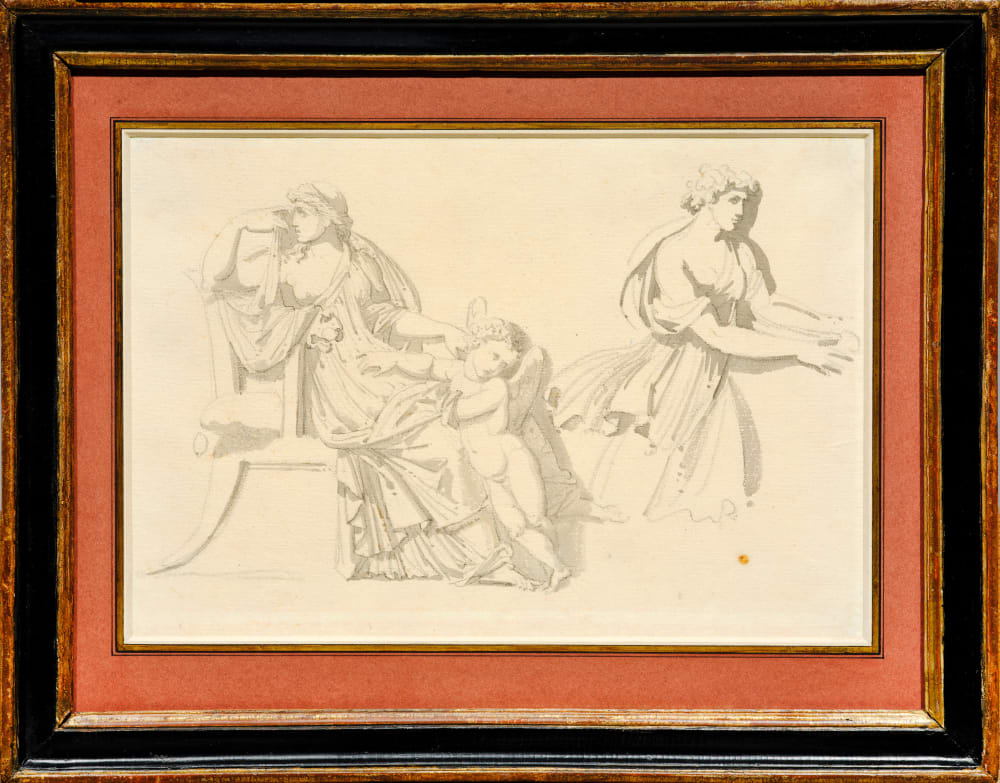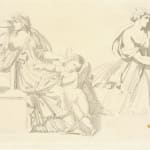 Jean-Baptiste Frédéric Desmarais - Portrait of Antoine-Denis Chaudet in 1788 - whereabouts unknown
Jean-Baptiste Frédéric Desmarais - Portrait of Antoine-Denis Chaudet in 1788 - whereabouts unknown
 Antoine-Denis Chaudet - Aristomenes finds Socrates in misery - Musée des Beaux-Arts d'Angers
Antoine-Denis Chaudet - Aristomenes finds Socrates in misery - Musée des Beaux-Arts d'Angers
 Antoine-Denis Chaudet - Napoleon as Hercules - (RF 3296) - Louvre Museum
Antoine-Denis Chaudet - Napoleon as Hercules - (RF 3296) - Louvre Museum
Antoine-Denis Chaudet
18.3 x 28.6 cm
Further images
Faithful to the neo-classical taste, sculptor Antoine-Denis Chaudet presents us with a frieze of antique figures executed in gray wash over pencil strokes, which is likely inspired by some antique bas-reliefs.
The short career of French sculptor Antoine Denis Chaudet, which spanned over just twenty years, was enough to make him the most influential French sculptor of the Napoleonic period. In addition to his work as a sculptor, he was also a book illustrator and, exceptionally, a painter.
His beginnings were easy: at the age of fourteen, he entered the workshop of Jean-Baptiste Stouf and the following year that of Etienne Gois. He was awarded the Prix de Rome in 1784, spent four years in Italy and returned to France in 1789. A fine painting by Jean-Baptiste Frédéric Desmarais recently sold at Sotheby's depicts him in 1788 at the end of his Italian sojourn.
On his return from Italy, he was admitted to the Académie Royale de Peinture et de Sculpture in 1789, but found himself without a commission due to the Revolution. It was at this point that he began to take an interest in illustration, in particular for Racine’s plays, which were published by Didot between 1801 and 1805. Under the Consulate and especially under the Empire, ha was made famous by his bust of Bonaparte, and produced two statues of the emperor, including the one that topped the Vendome Square column until 1814.
The number of his surviving drawings is estimated at around two hundred. Most were made after his return to Paris. The most important collections are those of the Musée du Louvre, which houses an album of some sixty drawings produced between 1802 and 1806, and those of the Bibliothèque Nationale (54 drawings for medals). His work is also represented in the collections of the Ecole des Beaux-Arts and in the museums of Angers, Besançon and Lille, as well as in the Kunstbibliothek in Berlin and the Pierpont Morgan Library in New York.[1]
His drawings are generally made with a light pencil line, then reworked with a pen or completed, as here, with a bistre or gray wash. Unlike other sculptors such as Bouchardon, Chaudet almost never uses red chalk.
It seems likely that our drawing was inspired by two separate antique bas-reliefs. The figure on the right, depicted without his feet, could have been inspired by a fragmentary bas-relief distinct from the woman sitting with a putto at her feet.
We have found two drawings presenting some similarities to the one presented here. The treatment of the woman on the left of our drawing evokes the technique used the man seated on the left in Aristomenes finds Socrates immersed in misery (Musée des Beaux-Arts - Angers), while the technique combining preparatory pencil drawing and ink wash can be found in the Portrait of Napoleon as Hercules, a drawing in the Musée du Louvre that has been reattributed to Chaudet.
Our drawing is presented framed in a small late 18th century frame in blackened and gilded wood.
Main bibliographical reference
Olivier Michel - Chaudet dessinateur - research published by the Société du Salon du Dessin (Dessins de Sculpteurs II) during the Quatrièmes rencontres internationales du salon du dessin on March 25 and 26, 2009
[1] Non-exhaustive list!







